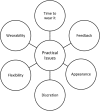A knee monitoring device and the preferences of patients living with osteoarthritis: a qualitative study
- PMID: 26346873
- PMCID: PMC4563249
- DOI: 10.1136/bmjopen-2015-007980
A knee monitoring device and the preferences of patients living with osteoarthritis: a qualitative study
Abstract
Objectives: To identify perspective of patients with osteoarthritis, in particular design requirements and mode of use, of wearable technology to support the rehabilitation pathway. This study is part of a user-centred design approach adopted to develop a rehabilitation tool for patients with osteoarthritis.
Design: Qualitative study using a focus group approach; data management via a thematic analysis of patients' responses.
Participants: 21 patients with osteoarthritis (age range 45-65 years) participated in 1 of the 4 focus groups. Recruitment continued until data saturation.
Setting: The study was conducted in a university setting.
Results: Main determinants of user acceptance of a wearable technology were appearance and comfort during use. Patients were supportive of the use of wearable technologies during rehabilitation and could recognise their benefit as monitors for their progress, incentives to adhere to exercise, and tools for more informed interaction with clinicians.
Conclusions: This paper should encourage adoption and development of wearable technology to support rehabilitation of patients with osteoarthritis. It is pivotal that technological development takes into account patients' views in that it should be small, light, discrete, not 'appear medical' or challenge the identity of the user. Derived data should be available to patients and clinicians. Furthermore, wearable technologies should be developed to operate in two modes: for exercise guidance and assessment only, and for unobtrusive everyday monitoring. The information obtained from this study should guide the design of new technologies and support their use in clinical practice.
Keywords: Focus group; Functional monitoring; Osteoarthirits; Rehabilitation; wearable system.
Published by the BMJ Publishing Group Limited. For permission to use (where not already granted under a licence) please go to http://group.bmj.com/group/rights-licensing/permissions.
Figures
References
-
- Lukowicz P, Kirstein T, Troster G. Wearable systems for health care applications. Methods Inf Med 2004;43:232–8. - PubMed
Publication types
MeSH terms
Grants and funding
LinkOut - more resources
Full Text Sources
Other Literature Sources


